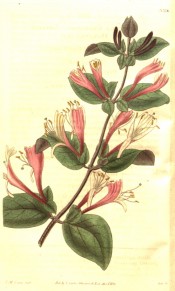Lonicera japonica Thunb.
Fully hardy, vigorous, woody, evergreen or semi-evergreen, twining climber with paired, ovate, sometimes lobed leaves, to 8cm long, and axillary pairs of tubular, very fragrant, often purple-flushed, white flowers, to 4cm long, ageing to yellow, throughout the summer, followed by blue-black berries. To 10m. [RHSE, Hortus, Hilliers’].
Horticultural & Botanical History
‘Being a native of China, it was at first treated as an inmate of the greenhouse or conservatory, but it now proves to be perfectly hardy, and I have scarcely witnessed a more beautiful sight than a plant of this honeysuckle, trained against the wall of Mr. Curtis’s house at his extensive Nursery at Glazenwood, with its long pendant shoots and its copious flowers, appearing through a great part of the summer and autumn and scenting the air with its fragrance.’ [BM t.3316/1834]. Introduced to Britain in 1806 by the East India Company. [BR f.70/1815]. ABR pl.583/1809.
History at Camden Park
Listed in all published catalogues [T.647/1843].
Notes
Lonicera japonica Andr. (c.1800) = Lonicera confusa DC.
Lonicera japonica Wall. (1824) = Lonicera macrantha Spreng.
Published Jul 08, 2009 - 04:15 PM | Last updated Jul 16, 2010 - 01:59 PM
| Family | Caprifoliaceae |
|---|---|
| Category | |
| Region of origin | Eastern Asia |
| Synonyms |
|
| Common Name | Japanese honeysuckle, Gold and silver flower, Kin-gin-qua |
| Name in the Camden Park Record | Lonicera Japonica - Japan Honeysuckle |
| Confidence level | high |
